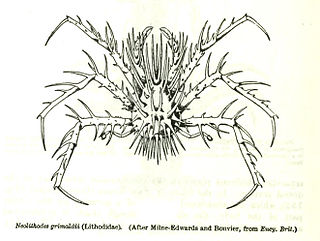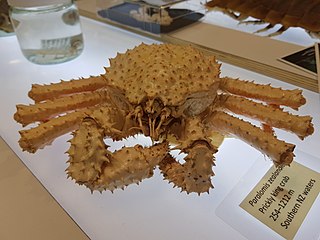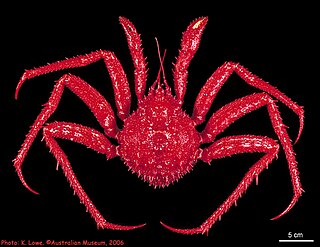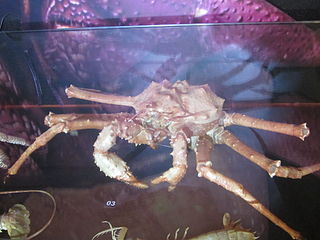
King crabs are a taxon of decapod crustaceans that are chiefly found in cold seas. Because of their large size and the taste of their meat, many species are widely caught and sold as food with the most common being the red king crab.

Lithodes is a genus of king crabs. Today there are about 30 recognized species, but others formerly included in this genus have been moved to Neolithodes and Paralomis. They are found in oceans around the world, ranging from shallow to deep waters, but mostly at depths of 100–1,000 m (300–3,300 ft). They are restricted to relatively cold waters, meaning that they only occur at high depths at low latitudes, but some species also shallower at high latitudes. They are medium to large crabs, and some species are or were targeted by fisheries.

Neolithodes is a genus of king crabs, in the family Lithodidae. They are found in all major oceans, both in high and low latitudes. Although there are records from water as shallow as 124 m (407 ft) in cold regions, most records are much deeper, typically 700–2,000 m (2,300–6,600 ft), with the deepest confirmed at 5,238 m (17,185 ft). They are fairly large to large crabs that typically are reddish in color and spiny, although the size of these spines varies depending on species.

Neolithodes grimaldii, the porcupine crab, is a species of king crab in the family Lithodidae. This large red crab is found in cold deep waters in the North Atlantic and often caught as a bycatch in fisheries for Greenland turbot. As suggested by its common name, the carapace and legs are covered in long spines.

Paralomis zealandica, also known as the prickly king crab, is a species of king crab which lives at a depth of 254–1,212 m (833–3,976 ft) in New Zealand. It has spiky carapace. The scientific name of the species was first validly published in 1971 by Dawson & Yaldwyn. P. zealandica can be distinguished from other species in New Zealand waters by its thick covering of strong upright spines all over, including on its abdomen and along its legs and claws. The rostrum has three short, strong and sharp spines. It is the most prominent species of Paralomis in New Zealand.

Neolithodes flindersi is a species of king crab found in southeastern Australia. They have been found at depths of 887–1,333 metres (2,910–4,373 ft) but typically appear from 950–1,050 metres (3,120–3,440 ft). They most closely resemble Neolithodes brodiei and Neolithodes nipponensis.

Neolithodes agassizii is a species of king crab native to the Western Atlantic. They live at depths of 200–1,900 metres (660–6,230 ft), and have been found as far south as Rio de Janeiro, as far north as latitude 36°, and near the Equator. It has been found in the southwestern Caribbean Sea as well as the Gulf of Mexico.
Neolithodes yaldwyni is a species of king crab which is found in the Ross Sea from depths of 124–1,950 metres (407–6,398 ft). It had previously been misidentified as Neolithodes brodiei, and it closely resembles Neolithodes capensis.
Neolithodes bronwynae, commonly known as the rock crab, is a species of king crab which is found at the Whakatane Seamount in the Bay of Plenty, the Lord Howe Rise near Lord Howe Island, and possibly New Caledonia. It lives at a depth of 1,515–1,920 metres (4,970–6,299 ft). It has long spines and a deep-red colour.

Neolithodes brodiei is a species of king crab which is native to New Zealand and its adjacent waters. It lives at a depth of 500–1,240 metres (1,640–4,070 ft) but is typically found within a depth of 950–1,150 metres (3,120–3,770 ft). It has a deep-red colour, and its carapace has many small spinules along with larger spines. It is classified as "Not Threatened" by the New Zealand Department of Conservation.
Neolithodes asperrimus is a species of king crab native to the coast of Africa. It has been found in South Africa and Mauritania at depths of 997–1,862 metres (3,271–6,109 ft), and Neolithodes aff. asperrimus has been found in Madagascar, Réunion, and the South Region of Brazil.
Neolithodes capensis is a species of king crab which is found in the Southern Ocean and the western Indian Ocean. It has been found to a depth of 660–3,200 metres (2,170–10,500 ft).

Neolithodes diomedeae is a species of king crab which is found in the eastern Pacific Ocean, the southwestern Atlantic Ocean, and the Bellingshausen and Scotia Seas in the Southern Ocean. They occur from 200 to 2,454 m.
Neolithodes nipponensis is a species of king crab which is found in Japan and Taiwan. It has been found at depths from 200–1,752 metres (656–5,748 ft).
Neolithodes duhameli is a species of king crab which is found in the Crozet Islands in the southwestern Indian Ocean from a depth of 620–1,500 metres (2,030–4,920 ft).
Paralomis dawsoni is a species of king crab which lives in New Caledonia, New Zealand, and the Solomon Islands at depths of 400–1,118 m (1,312–3,668 ft). It is the largest species of Paralomis in New Zealand.
Neolithodes indicus is a species of king crab found in the Arabian Sea. It has been found at depths between 743–1,829 m (2,438–6,001 ft). It was originally identified erroneously as Lithodes agassizii by A.R.S. Anderson in 1896.
Lithodes longispina is a species of king crab. It has been found in Japan and Taiwan. Before 2010, its reach was thought to be much greater than presently understood, such as Australia, New Zealand, and Guam. It has also allegedly been sighted in the Northwestern Hawaiian Islands.
Lithodes megacantha is a species of king crab in the genus Lithodes. They are bright red and have been found in French Polynesia at depths of around 1,000 m (3,300 ft).

Lithodes turritus is a species of king crab. It is found in Japan, the East China Sea, Taiwan, and the Philippines at depths from 300–812 metres (984–2,664 ft).









